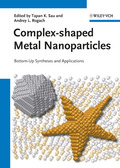Complex-shaped Metal Nanoparticles
Bottom-Up Syntheses and Applications

1. Edition July 2012
XXIV, 558 Pages, Hardcover
35 Pictures (35 Colored Figures)
Monograph
Short Description
Renowned researchers from all over the world present existing knowledge of the field, covering all important aspects and techniques of preparation and characterization of nanoparticles with controlled morphology and architecture, from the basics right up to recent developments.
Buy now
Price: 185,00 €
Price incl. VAT, excl. Shipping
Euro prices for Wiley-VCH and Ernst & Sohn titles are only valid for Germany. In EU countries, local VAT applies. Postage will be charged.
- Out of print -
The past few years have witnessed the development of non-spherical metal nanoparticles with complex morphologies, which offer tremendous potential in materials science, chemistry, physics and medicine.
Covering all important aspects and techniques of preparation and characterization of metal nanoparticles with controlled morphology and architecture, this book provides a sound overview - from the basics right up to recent developments. Renowned research scientists from all over the world present the existing knowledge in the field, covering theory and modeling, synthesis and properties of these nanomaterials.
By emphasizing the underlying concepts and principles in detail, this book enables researchers to fully recognize the future research scope and the application potential of the complex-shaped metal nanoparticles, inspiring further research in this field.
METAL NANOPARTICLES OF COMPLEX MORPHOLOGIES: A GENERAL INTRODUCTION
COLLOIDAL SYNTHESIS OF NOBEL METAL NANOPARTICLES OF COMPLEX MORPHOLOGIES
Introduction
Classification of Nobel Metal Nanoparticles
Synthesis Methodologies
Characterization
Thermodynamic-Kinetic Factors and Particle Morphology
Mechanisms of Morphology Evolution
Conclusions and Outlook
CONTROLLING MORPHOLOGY IN NOBLE METAL NANOPARTICLES VIA TEMPLATING APPRAOCH
Introduction
Galvanic Replacement Method
Hard Template-Directed Method
Soft Template-Directed Method
Conclusions and Outlook
SHAPE-CONTROLLED SYNTHESIS OF METAL NANOPARTICLES OF HIGH SURFACE ENERGY AND THEIR APPLICATIONS IN ELECTROCATALYSIS
Introduction
Fundamentals and Background
Progress in Shape-Controlled Synthesis of Metal Nanoparticles of High Surface Energy and Their Applications
Theoretical Simulations of Structural Transformation and Stability of Metal Nanoparticles with High Surface Energy
Conclusions
SHAPE-CONTROLLED SYNTHESIS OF COPPER NANOPARTICLES
Introduction
Metallic Copper
Electrodeposition Method for Growth of Cu Nanoparticles of Different Shapes
Conclusions
SIZE- AND SHAPE-VARIANT MAGNETIC METAL AND METAL OXIDE NANOPARTICLES: SYNTHESIS AND PROPERTIES
Introduction
Synthesis of Size- and Shape-Variant Ferrite Nanoparticles
Other Magnetic Nanoparticles: Synthesis, Size Variance, and Shape Variance
Magnetism in Ferrite Nanoparticles
Magnetic Nanoparticles for Biomedical Applications
Concluding Remarks and Future Directions
STRUCTURAL ASPECTS OF ANISOTROPIC METAL NANOPARTICLE GROWTH: EXPERIMENT AND THEORY
Introduction
Atomic Packing on Metal NPs
Structural Aspects in the Anisotropic Growth: The Silver Halide Model
Experimental Requisites to Produce Anisotropic NPs
Concluding Remarks
COLLOIDS, NANOCRYSTALS, AND SURFACE NANOSTRUCTURES OF UNIFORM SIZE AND SHAPE: MODELING OF NUCLEATION AND GROWTH IN SOLUTION SYNTHESIS
Introduction
Burst Nucleation Model for Nanoparticle Growth
Colloid Synthesis by Fast Growth
Improved Models for Two-Stage Colloid Growth
Particle Shape Selection in Solution Synthesis
Applications for Control of Morphology in Surface Structure Formation
Summary
MODELING NANOMORPHOLOGY IN NOBLE METAL PARTICLES: THERMODYNAMIC CARTOGRAPHY
Introduction
Ab Initio Simulation of Small Gold Nanoclusters
Ab Initio Simulation of Gold Nanoparticles
Thermodynamic Cartography
Gold Nanorods and Dimensional Anisotropy
Comparison with Platinum and Inclusion of Surface Defects
Conclusions
PLATINUM AND PALLADIUM NANOCRYSTALS: SOFT CHEMISTRY APPROACH TO SHAPE CONTROL FROM INDIVIDUAL PARTICLES TO THEIR SELF-ASSEMBLED SUPERLATTICES
Introduction
Influence of the Chemical Environment on the NC Shape
Synthesis of Platinum Nanocubes
Supercrystals Self-Assembled from Nonspherical NCs
Conclusions
ORDERED AND NONORDERED POROUS SUPERSTRUCTURES FROM METAL NANOPARTICLES
Introduction
Metallic Porous Superstructures
Summary and Outlook
LOCALIZED SURFACE PLASMONS OF MULTIFACETED METAL NANOPARTICLES
Introduction
Light Absorption and Scattering by Metal NPs
Spectral Representation Formalism
Spherical and Spheroidal NPs
Discrete Dipole Approximation
SPRs in Multifaceted Morphologies
Summary
FLUOROPHORE-METAL NANOPARTICLE INTERACTIONS AND THEIR APPLICATIONS IN BIOSENSING
Introduction
Fluorescence Decay Rates in the Vicinity of Metal Nanostructures
Shaping of Fluorescence Spectra by Metallic Nanostructures
Shaping of Extinction Spectra by Strong Coupling
Specific Issues on the Interaction of Fluorophores with Complex-Shaped Metallic Nanoparticles
SURFACE-ENHANCED RAMAN SCATTERING USING COMPLEX-SHAPED METAL NANOSTRUCTURES
Introduction
Basics
Modeling
SERS Substrate Preparation
Fundamental Studies
Applications
Conclusions and Outlook
PHOTOTHERMAL EFFECT OF PLASMONIC NANOPARTICLES AND RELATED BIOAPPLICATIONS
Introduction
Theory of the Photothermal Effect for Single Nanoparticles and for Nanoparticle Clusters
Physical Examples and Applications
Application to Biological Cells: Control of Voltage Cellular Dynamics with Photothermal Actuation
Summary
METAL NANOPARTICLES IN BIOMEDICAL APPLICATIONS
Introduction
Biosensing and Diagnostics
Therapeutic Applications
Bioimaging
Conclusions and Outlook
ANISOTROPIC NANOPARTICLES FOR EFFICIENT THERMOELECTRIC DEVICES
Introduction
Chemical Synthesis Methods of Complex-Shaped TE NPs
One-Dimensional TE NPs
Two-Dimensional TE NPs
Other Complex-Shaped TE NPs
Properties of Complex-Shaped TE NPs
Conclusions and Future Outlook
Andrey L. Rogach is chair professor at the Department of Physics and Materials Science of City University of Hong Kong. After his PhD in chemistry, obtained from the Belarusian State University in Minsk, he had worked as a research scientist at the University of Hamburg, Germany (1995-2002), and as a lead staff scientist at the Photonics and Optoelectronics group of the Ludwig-Maximilians-Universität Munich, Germany (2002-2009), where he completed his habilitation in experimental physics. His research is focused on synthesis, assembly, optical spectroscopy and applications of colloidal semiconductor and metal nanocrystals, which has been extensively (over 12,000) times cited.


